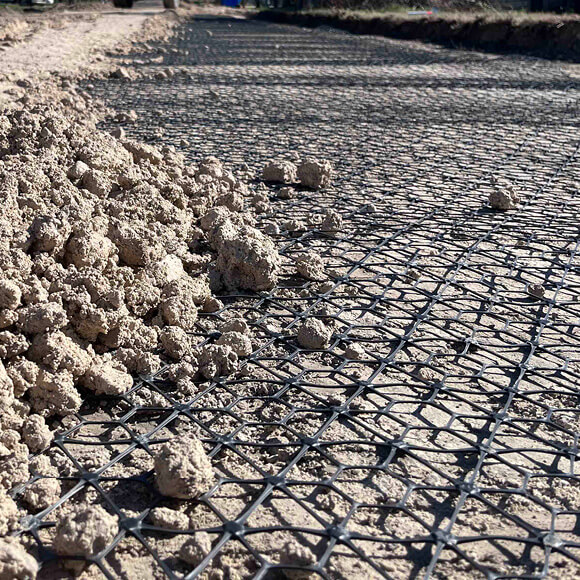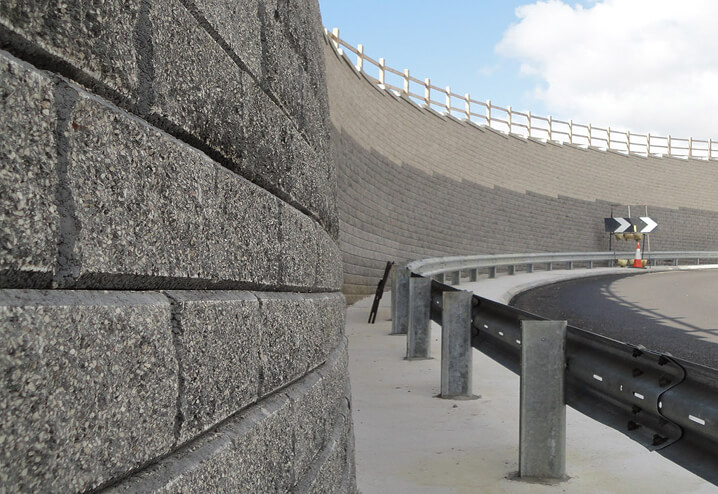What Is the Shear Strength of Soil? Tests & Formula
by Andrew Lees, on August 29, 2024
The shear strength of soil is defined as its resistance to deformation when subjected to shear stress, which is influenced by cohesion and the internal friction angle. Understanding the shear strength of soil is key knowledge for ground engineers and is vital to any design project.
Everything that is built makes contact with the ground and transfers load into it. As such, it's essential to understand and quantify the shear strength of the soil during the design phase, ensuring that you avoid any construction catastrophes which can arise from the shear failure of soil.
In this guide, we’ll first explore what is meant by the shear strength of soil and its importance, before looking at the influence of groundwater and the impact of soil state on the shear strength of soil. Finally, we’ll discuss soil shear strength tests and the formula used to calculate them.
Use the links below to jump to the section you’re most interested in:
- What is meant by the shear strength of soil?
- Why is shear strength of soil important?
- Which factors impact soil shear strength?
- The influence of groundwater on the shear strength of soil
- The impact of soil state on the shear strength of soil
- How to do soil shear strength tests
- The shear strength of soil formula
- Application of engineering signifiance
If you're looking to account for and improve the shear strength of soil as part of a civil engineering project, Tensar offers design support that can help. Get in touch to find out more.
What is meant by the shear strength of soil?
Shear strength is a material's ability to resist forces that cause its internal structure to slide against itself.
The shear strength of soil determines its resistance to deformation by tangential (or shear) stress. Soil that has greater shear strength will have more cohesion between particles, and more friction or interlocking to prevent particles from sliding over each other. Testing the shear strength of soil is critical to geotechnical engineering projects, such as calculating bearing capacity and designing earth retaining walls, slopes and embankment stabilisation.
Effective soil stabilisation techniques can enhance shear strength, ensuring more stable and durable construction in challenging soil conditions.
Why is the shear strength of soil important?
Understanding the shear strength of soil is vital in geotechnical engineering in order to determine how design projects will respond to shear stress and different amounts of load. Soil strength enables us to work out the ground bearing capacity when designing building foundations, pavements or temporary access roads – equally, soil shear strength indicates how stable retaining walls, slopes and embankments will be.
Which factors impact soil shear strength?
Soil shear strength depends on many elements, one fundamental consideration being the type of soil. The particles of most soils are essentially incompressible, and soil masses have no tensile strength. Soils fail when one block of soil moves relative to another block and the soil particles at the failure plane move over each other.
This is what is known as shear. When particles move across each other, the resisting (or shear) force is friction. The shear resistance, or shear strength of soil, is related to the physical characteristics of the soil, including soil particle size, shape, distribution and orientation, but also the stresses acting on the soil at that location.
Ground Coffee 'Ask Andrew' Episode 5: Andrew Lees explains what the shear strength of a soil is.
Friction
A key element of soil shear strength is friction. For objects in contact, the friction force along a plane varies with the pressure acting perpendicular to the plane (known as normal stress). As normal stress increases, so too does frictional resistance, or shear stress. This underlines that soil shear strength is not a single figure but is dependent upon the stresses that are acting upon a soil.
For granular soils, the relationship between shear stress and normal stress is a straight line, defined by an angle (ø) known as the soil friction angle.
Friction angle of soil
When considering shear strength, it is important to know the friction angle of soil, as well as the stresses which will be acting on the soil. When comparing different types of granular soil, the friction angle is the single property that defines strength. The friction angle of soil is critical when sourcing materials for structural fill in reinforced soil structures and is important for applications such as working platforms and road foundations. It is also essential to remember that any change in friction angle may necessitate a redesign.
Clay soil shear strength
Clay soils are also composed of particles, although the particles are extremely small. There are electrostatic charges (attractive forces) acting between these fine particles, and surface tension from pore water holds particles together even without the application of external confining forces; hence, clay soils have some shear strength even when normal stress is zero.
This additional strength is known as apparent cohesion. It is not, however, a fundamental soil property. When considering the shear strength of granular soils, even those with some clay content, cohesion can mostly be ignored as it is the friction angle which is key.
The influence of groundwater on the shear strength of soil
The presence of groundwater also has a marked influence on soil shear strength. Therefore, understanding the undrained shear strength of soil is vital for determining how much load can be supported. Soils can be saturated, where all void spaces between particles are filled with water, or partially saturated when a percentage of air bubbles are present within the void spaces.
The pore pressures generated affect particle-to-particle stress and, therefore, friction between soil particles. When a load is applied to saturated soil, the pressure of the pore water (water in the spaces) immediately increases because water is incompressible. The permeability of soils becomes a critical factor in how quickly water can dissipate.
Granular soils have relatively large interconnecting voids between particles. When – as is usually the case in construction – loads are applied slowly onto a granular soil, water can be assumed to drain away freely, dissipating any increased pore pressure and allowing the applied load to be transferred to the soil skeleton. Consequently, pore water effects can be ignored.
Clay soil reacts differently as the voids are microscopically small and poorly interconnected. Water can therefore only move at much lower rates, and drainage is very slow, so when a load is applied to clay soil, the pore water pressure is unable to dissipate. As water is incompressible, the pore water pressure carries the load, and the particle-to-particle stresses in the clay do not increase. The short-term saturated shear stress of clay soil is therefore a constant value referred to as the undrained stress, denoted by cu or su.
When considering the bearing capacity of clay soils, the undrained shear strength is critical. This is extremely common in the UK, where soils with high clay content are found on many construction sites. Over time, water will drain from clay and the pore pressure will slowly reduce; therefore, the strength of the clay soils will increase – however, this is a very long-term effect.
The impact of soil state on the shear strength of soil
A further factor affecting granular soil shear strength is the degree of particle compaction or soil state. When a load is applied to loose, uncompacted soil, the particles will move closer together as the soil contracts. After contraction of the soil, shearing takes place as particles begin to move over each other. The soil shear strength increases as the particles compact, ultimately continuing at a constant level and constant density or volume.
Where granular soils are already densely compacted, little or no contraction takes place, and particles are interlocked. As the load increases, before particles can shear over one another, they have to move apart along the shear plane, unlocking the interlock. This is known as dilation. The shear force required to overcome dilation is the ‘peak strength’ (øpeak). After dilation, particles can move over each other more easily, requiring a lower shear force than at peak, which is referred to as strength at constant volume øcv.
In a situation where the soil is not expected to shear – for example, the structural fill in a reinforced soil wall – the peak strength should be used in the design. If addressing a high deformation condition, the preferred option would more likely be the shear strength of the soil at constant volume. This consideration is particularly important when dealing with lateritic soil, which, due to its unique properties, may exhibit varying shear strengths depending on the degree of compaction and moisture content. The key is to ensure that the materials report provides the appropriate strength for the design purpose.
Visit our TensarTech Wall & Slope Systems page to find out more about how these systems support earth retaining structures, embankment foundations and working platforms.
Other external factors affecting the shear strength of soil
Beyond cohesion and the angle of internal friction, several other factors can significantly influence the shear strength of a soil.
Moisture content and saturation can also affect soil shear strength. For cohesive soils, increasing moisture content generally decreases effective cohesion and thus shear strength. Saturation can lead to the loss of apparent cohesion and a significant reduction in strength. For granular soils, moisture content has less direct impact on the angle of internal friction, but saturation can influence pore water pressure generation.
In addition, while less pronounced than other factors in typical civil engineering applications, significant temperature changes can affect the viscosity of pore water and the compressibility of soil particles, which can subtly influence shear strength.

Methods for shear strength tests
A shear strength test on soil can be done in a number of ways:
- The vane shear test
- The borehole shear test
- The direct shear test
- The triaxial test
- The unconfined compression (UCC) test
The vane shear test
This is an in-situ test of the undrained shear strength of cohesive soils (for example, clay-based soils) and can only be carried out on samples with a soil shear strength of up to 0.5 kgf/cm2. A “vane shear tip” is inserted into a borehole on a site and rotated to work out the torsional force required to cause shearing.
The borehole shear test
Another in-situ shear strength of soil test for use on soft clays. A device is inserted into the borehole and filled with compressed air to expand into the soil. As the soil shears, the shear strength can be estimated.
The direct shear test
A simple lab-based shear strength test is performed in a ‘shear box’. A soil sample is positioned in a shear box on a predefined horizontal plane. The specimen is placed under different normal stresses, and the tangential (shear) stress is determined in each case (the consolidation stage). Next, during the shearing stage, a shear stress is applied along the predetermined horizontal plane to determine the shear strength of the sample.
The triaxial test
These shear strength tests can be carried out on all soil types regardless of drainage condition. The term ‘triaxial’ refers to the fact that the soil sample is subjected to pressure in all directions during this type of test. See our guide to the triaxial test for more information.
The unconfined compression (UCC) test
A specific type of triaxial test that can only be conducted on saturated cohesive soils. In this case, the cell in which the test takes place has no confining pressure.
The shear strength of soil formula
The shear strength formula outlines the Mohr–Coulomb envelope, which states that the shear strength is equal to the sum of cohesion (c) and a frictional component (σ’tanφ). The shear strength formula of granular soils is:
τ=c+σ’tanφ
τ = soil shear strength (kPa)
c = cohesion (kPa)
σ’ = normal effective stress (kPa)
φ = the fractional angle
Applications of shear strength tests and their engineering significance
Design of foundations, slopes, embankments, retaining structures — largely governed by soil shear strength. The understanding and accurate determination of soil shear strength are paramount in geotechnical engineering. It forms the basis for the design and analysis of virtually all earth structures and foundations.
On the other hand, in a project where soil shear strength is defined as low, it can be increased by mechanical stabilisation and chemical processes, as well as through the use of reinforcing materials. For example, engineers can adapt their designs based on the shear strength of soil by introducing suitable geogrids or retaining wall systems.
Application 1: Design of foundations
The bearing capacity of construction foundations, which is the maximum pressure a soil can support without excessive settlement or shear failure, is directly calculated using the soil's shear strength parameters ($ c' $, ϕ′ or cu). Assessing the shear strength accurately can allow engineers to design a safe construction foundation and working platform.
Application 2: Design of slopes and embankments
The stability of slopes and engineered embankments is assessed by comparing the driving forces that promote sliding with the resisting forces provided by the soil's shear strength along potential failure surfaces. In addition, the construction of embankments involves placing fill materials (like aggregate), and their stability during and after construction depends on the shear strength of both the fill material and the underlying foundation soil.
Application 3: Design of retaining structures
Retaining walls are designed to hold back soil masses. The lateral earth pressures exerted by the soil on the wall, and the wall's resistance to overturning and sliding, are directly calculated using the shear strength parameters of the retained soil and the foundation soil.
Application 4: Railway track and embankment
The stability and performance of railway and rail trackbed, especially the subgrade and ballast layers, are heavily dependent on the shear strength of the surrounding soil. Adequate shear strength prevents collapse and allows for safe excavation. If the existing soil has inadequate shear strength, ground improvement techniques like soil stabilisation and pile foundation might be implemented.
Contact Tensar for design support
Now that you understand the meaning of shear strength of soil, its importance in geotechnical engineering, the factors that affect this soil property, the various shear strength tests and formulas used to calculate it, you’re better equipped to apply this knowledge in your projects.
Tensar manufactures a range of geotechnical engineering solutions that can improve shear strength, such as geogrids and retaining wall systems. You can assess the needs of your project and compare Tensar's geogrid solutions by using our award-winning design software, Tensar+.
Contact us today for any further information, assistance or design support for shear strength solutions.



.png?width=400&height=400&ext=.png)
